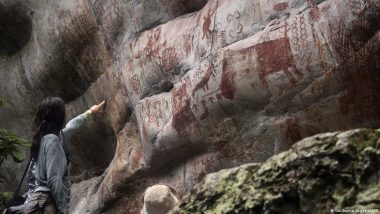Ancient humans moved to America 25,000 years ago. They told stories of their lives and how they changed the environment in stunning cave art.Humans first crossed into the American continent from Asia via the Bering Strait in several waves of migration between 25,000-15,000 years ago. The migrating hunter-gatherers found landscapes untouched by humans and full of unknown plants and animals.
Paleo-Indian cultures migrating through (what is now) Latin America left traces of their lives, painting rock art in caves and on cliff faces.
These paintings trace how early cultures learned to live in their new environments. They also give researchers clues about the ways the ancient humans left their legacies on the region's biodiversity and culture today.
Key evidence about early Paleo-Indian culture has come from Latin America's oldest cave art at Serranía de La Lindosa, in Colombia.
The paintings there are thought to be 12,800 years old, which dates them around the end of the Ice Age.
Francisco Javier Aceituno, an archeologist at the University of Antioquia, Colombia, described the art there as "photographs of the past." Aceituno has spent years studying the caves .
"We have been able to compare the rock paintings with the results of the archaeological excavations we have carried out. We have excavated the 'houses of the artists' who painted the wall," he told DW via email.
The art, mostly in red ochre, depicts various animal species, which some scholars suggest could be now-extinct animals, such as ground sloths and species of native horses, or domesticated species, including cows and dogs.
But these scenes of nature are more than just creative expressions. Experts believe the drawings served as educational tools that helped teach younger generations when and how to manage different plant and animal species — not just in Colombia, but all over South America.
Evidence found in a Patagonian cave, for example, suggests paintings from 8,200 years ago were used to pass information across 130 human generations, perhaps helping people to survive changing climates.
Cave art shows early spirituality
Much of the cave art at Serranía de La Lindosa, as well as those in other parts of South America, contain symbolic art depicting the spiritual world.
"[There are] scenes of dancing rituals or shamanic rites. With these spiritual scenes, [people were] trying to domesticate the natural world by controlling the forces of nature," said Aceituno.
Spirituality is evident in ancient art all over the world, both through painting and music. Experts say this evidence reveals the earliest forms of religion, when humans formed a sacred connection with the natural world.
Hallucinogenic drugs, of which many are native across the Americas, may have played an important role in early spirituality and religious ceremonies.
Paleo-Indians in California, for example, were thought to have used hallucinogenic drugs to induce spiritual states, like LSD parties which swept California in the 1960s or contemporary Ayahuasca use in Brazil.
How did Paleo-Indian cultures influence modern Amazonia?
Between 13,000-8,000 years ago, Amazonia transformed from a dry savannah and scrubland into the tropical rainforests we know today.
The period saw rapid changes in climate and local cultures had to learn to adapt.
Excavations at Serranía de La Lindosa allowed Aceituna and his colleagues to indirectly date the cave art to the beginning of this period of transformation.
But the most amazing discovery, said Aceituna, was that human cultures had lived in the Serranía de La Lindosa for over 12,000 years.
Aceituna believes they may have strongly influenced Amazonia's biodiversity and plant-life during the climate transition — and that we can still see this today.
Rock art in the region, for example, shows hints that humans were managing plant species about 9000 years ago. That could explain a persistence of useful plants in Amazonia now.
Amazonia has an unusual richness of plants used for food and medicine. Many medicines and drugs, including quinine and cocaine originate from the Amazon, earning it the nickname "the world's largest medicine cabinet".
"They [Paleo-Indians] achieved a balance in the management of natural resources. Plants and animals were more than food — they were also seen as living beings to be respected. [People used] the preservation principle: I cannot extinguish my resources, my food," Aceituno said.
Genetic history of Indigenous groups not yet known
Another legacy, Aceituna said, was the heritage of Paleolithic groups in ethnic groups living in Latin America today.
"Current Indigenous groups [in the region] have inherited some traditions and ways of exploiting the forest, and [Mesoamerican] cosmovision," said Aceituna.
Elements of the Mesoamerican cosmovision — their worldview — can be seen in things like the Day of the Dead ceremony and the Indigenous belief that everything in the universe is part of a pair.
But we cannot be sure that current Indigenous communities are direct descendants of Paleo-Indian cultures "in a biological sense," said Aceituna.
Recent advances in testing ancient DNA could, however, help discover the genetic history of local Indigenous groups, and with the help of other cave art, trace how their cultures spread around South America.
Edited by: Zulfikar Abbany
Sources:
Colonisation and early peopling of the Colombian Amazon during the Late Pleistocene and the Early Holocene: New evidence from La Serranía La Lindosa, in Quaternary International, 2021, by Gaspar Morcote-Ríos, Francisco Javier Aceituno, et al. https://doi.org/10.1016/j.quaint.2020.04.026
Earliest directly dated rock art from Patagonia reveals socioecological resilience to mid-Holocene climate in Science Advances, 2024, by Guadalupe Romero Villanueva et al. https://www.science.org/doi/10.1126/sciadv.adk4415
Datura quids at Pinwheel Cave, California, provide unambiguous confirmation of the ingestion of hallucinogens at a rock art site in PNAS Anthropology, 2020, by Robinson DW, Brown K, McMenemy M, et al. https://www.pnas.org/doi/suppl/10.1073/pnas.2014529117
(The above story first appeared on LatestLY on Apr 12, 2024 04:40 PM IST. For more news and updates on politics, world, sports, entertainment and lifestyle, log on to our website latestly.com).













 Quickly
Quickly




















